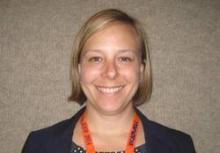MINNEAPOLIS – People with seasonal affective disorder (SAD) have reduced retinal sensitivity to light all year long, suggests a study reported at the annual meeting of the Associated Professional Sleep Societies. And such lower sensitivity predicts the night-owl behavioral pattern that is one feature of this disorder.
Individuals with SAD, compared with healthy controls, have impaired cellular responses in a specific neural pathway, Kathryn A. Roecklein, Ph.D., of the University of Pittsburgh, said in an interview. "This neural pathway starts in the retina," with ganglion cells containing the protein melanopsin, "and goes to the central circadian clock in the brain and allows our bodies to synchronize with the environmental light/dark cycle."
"Surprisingly, melanopsin cell responses were lower in SAD year-round, in summer and winter, compared with controls. This means that impaired melanopsin cell responses are likely to make individuals vulnerable to SAD when light levels are lower on dark, winter days," she added.
In the study, the investigators measured the sensitivity of melanopsin cells to light with the postillumination pupil response (PIPR) test, and they plan to assess whether this test predicts treatment response, according to Dr. Roecklein.
"We are hoping that the PIPR test, which is similar to going to the ophthalmologist, will offer patients and their doctors a quick and easy way to choose from the multiple treatment options for depression: light therapy, antidepressant medication, and psychotherapy," she explained. Such prediction "could improve treatment fidelity, motivation to engage in treatment, and response rates."
The study "was an interesting look at the possible underpinnings of SAD, based on testing on the physiological responses from light coming into the eye," session chair Dr. Douglas B. Kirsch of the Sleep Disorders Service at the Brigham & Women’s Hospital in Boston commented in an interview.
"This novel research may eventually help identify people at risk for SAD and, looking forward, may phenotype the SAD patients most likely to respond to different treatments such as light or antidepressant medication," he agreed.
Previous research has shown that relative to unaffected peers, people with SAD have a reduced melanopsin cell response in winter (Psychiatry Res. 2013;210:150-158), but it is unclear whether this is a season-specific phenomenon.
In their study, the investigators measured postillumination pupil response during summer and winter in 33 individuals with SAD and 17 healthy individuals, using 1-second light exposures to red light and to blue light for testing.
Relative to healthy peers, individuals with SAD had a smaller postillumination pupil response year-round (P = .004). But in addition, going from summer to winter, the response decreased in the SAD group whereas it increased in the healthy group, suggesting that SAD is also due to failure of a normal upregulation that kicks in as light dwindles later in the year, according to Dr. Roecklein.
Additional results showed that individuals with a smaller postillumination pupil response were more likely to be night owls vs. early risers (P less than .00001).
After adjusting for age and sex, the SAD group had more of a night-owl pattern than did the healthy group year round (P less than .001), although within the former group, this pattern was somewhat more pronounced in the winter.
The study was funded by a grant from the National Institutes of Health and supported by the University of Pittsburgh Sleep Medicine Institute, and the Center for the Neural Basis of Cognition, a joint venture between the University of Pittsburgh and Carnegie Mellon University. The authors reported having no financial disclosures.


